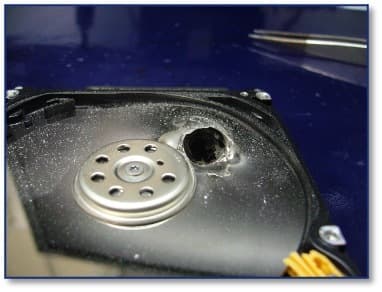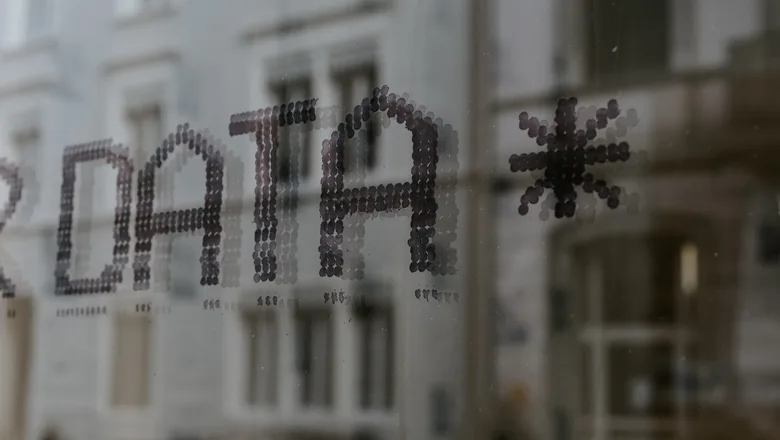Picture this: you are a business owner who just had to lay off thousands of employees due to the looming recession. As part of the process, you had to securely dispose of all computer equipment and hard drives containing sensitive company and customer information. You can’t just throw these items into the trash, as this would make your data vulnerable to theft.
Even though you took every precaution to protect the data, you still could not assure that it would never be accessed by an unauthorized person because of the increasing sophistication of cyberattacks. Your organization still gets hit with a massive data breach, and your customers’ personal information is now in the hands of criminals.
Employee turnover is an inevitable aspect of running a business, but many CEOs do not consider the effects turnover can have on data security. Data destruction should be an integral part of a comprehensive data protection strategy. Too often, organizations don’t pay enough attention to data destruction and leave themselves open to data breaches and other cyber threats.
The average global cost of a data breach is $4.35 million. Many of these expenses are a result of the legal consequences of data breaches. But the effects of breaches don’t end there—some organizations pass on the expenses to customers by raising the prices of their products or services in response to a breach. This can severely harm customer loyalty and result in lost business.
When information is not properly destroyed, it can easily fall into the wrong hands. Data thieves can use this information for malicious purposes or sell it on the dark web.
Data destruction is one of the most effective ways to protect sensitive data and prevent unauthorized access. After being destroyed, data cannot be recovered by email archiving, recovery software, or other means. By destroying physical media, businesses can ensure that any confidential information stored on them cannot be accessed or used by criminals. Additionally, organizations should destroy digital assets like emails, files, and hard drives since data thieves are always trying to find ways to gain access to them.
Although data destruction is just one element of a comprehensive security strategy, it should not be overlooked. By investing in a company that provides comprehensive data destruction services, businesses will be able to reduce their risk of data breaches and protect their confidential information from falling into the wrong hands. Let's take a closer look at what data destruction is, how it works, and the steps businesses can take to securely destroy data.
What is Data Destruction?
Data destruction is the process of securely destroying digital and physical media containing valuable information.
Types of Data Organizations May Destroy
-
Confidential files and documents
-
Hard drives and other digital media
-
Business records and customer information
-
Credit card numbers, social security numbers, and other sensitive financial information
-
Intellectual property
The goal is to render the data irrecoverable, making it impossible for anyone to access or use it. Depending on the type of data, organizations may use physical or digital destruction options.
Data destruction is typically done in a variety of ways depending on the type of media being destroyed. For example, physical media such as CDs and hard drives are often physically shredded or burned, while digital media such as emails and files can be deleted using data-wiping software.
Data destruction is a necessary security measure for any business, regardless of size or industry. Organizations must ensure that any confidential information stored on physical or digital media is irrecoverably destroyed to protect it from falling into the wrong hands and prevent malicious actors from accessing the data.
The Dangers of Data Exploitation
Data exploitation is the use of confidential information that has been illegally accessed or acquired for malicious purposes. It is a common practice among cybercriminals. They can use the data they acquire from organizations to commit various types of fraud, including:
Identity Theft
Malicious actors can use stolen data such as social security numbers and credit card numbers to steal an individual’s identity. Then, they can use this information to purchase goods and services in the victim’s name or even apply for loans.
Financial Fraud
Cybercriminals can use stolen financial information to open up new accounts in the victim’s name and make unauthorized purchases. Other examples of financial fraud include opening up new credit cards and making withdrawals from bank accounts.
Phishing Scams
Malicious actors can use personal information such as email addresses to target victims with phishing emails or malicious attachments. A phishing scam is an attempt to gain access to sensitive information or money by posing as a legitimate entity.
Data exploitation is a serious threat that can have devastating consequences for both individuals and businesses. Data breaches can not only lead to financial losses, but also reputational damage, legal action, and a loss of trust from customers and other stakeholders. The importance of securely destroying data cannot be overstated.
How Does Data Destruction Work?
The data destruction process depends on the type of media being destroyed. There are two main categories of data destruction: physical and digital.
Depending on the type of media, organizations may use various methods to destroy the data. Hard drives and other digital media can be deleted or wiped using software or specialized hardware. Physical media such as CDs and paper documents can be shredded or burned to make the data irrecoverable.
Methods for Data Destruction
Now, let's take a look at the different methods organizations can use for data destruction.
Shredding
Shredding hard drives is one of the most popular methods for physical data destruction. This process involves using a professional shredder to physically grind up the drive, rendering it unusable and all data stored on it irrecoverably destroyed. This only works for hard drives, however, not CDs or DVDs.
Degaussing
Degaussing is another method for physical data destruction. This process uses a specialized machine to generate an electromagnetic field that destroys any magnetic signals stored on hard drives, rendering them unusable and all data stored on them irrecoverably destroyed. Degaussing is a fast and cost-effective way to destroy hard drives, but once again, it does not work on CDs or DVDs.
Overwriting
Overwriting is a data destruction method that involves writing over existing data with random 1s and 0s multiple times. This process makes it impossible to recover any of the data that was stored on the device. Overwriting is an effective way to securely destroy digital assets, as it ensures that any confidential information stored on the device is irrecoverably destroyed. However, it is important to note that overwriting does not work for physical media.
Reformatting
Reformatting is a process in which all of the data stored on a device is erased. This method is often used for digital media such as removable storage devices, hard drives, and other types of media. While reformatting can render data unrecoverable, it is important to note that some data may still be recoverable with specialized software. Therefore, reformatting is not as reliable or secure as other data destruction methods such as overwriting or degaussing.
Encryption
Encryption is not technically a data destruction method, but rather a data protection method. Encryption involves using software to encode information in such a way that it can only be accessed by those who have the encryption key. This makes it impossible for anyone without the key to access or recover any of the data stored on the device. It is important to note that encryption is not a foolproof way to protect data, as there are ways for attackers to break through encryption. However, it is still a good general way to protect data from unauthorized access.
Physical Destruction
Finally, physical destruction is another method for destroying data. This process involves physically destroying the device, rendering it unusable and all data stored on it irrecoverably destroyed. Physical destruction is the most secure way to destroy data, as it ensures that no one can recover any of the information stored on the device. This method is often used for hard drives and other physical media, such as CDs and DVDs.
No matter which method is used for data destruction, it is critical to ensure that all information stored on the device has been irrecoverably destroyed. This will ensure that all of the confidential information stored on the device remains secure, and that no one can access it without authorization.

Why Certificates of Destruction Are Critical
A certificate of destruction is a document used to certify that data has been securely destroyed. This document acts as evidence that an organization has complied with all applicable laws and regulations regarding the secure disposal of data.
The certificate should include key details, such as:
-
The type of media destroyed
-
Date of destruction
-
A unique identifier for the media destroyed
-
Name of the company responsible for destruction
-
The method used for secure destruction
-
A digital signature from the data destruction professional
Certificates of destruction are an important part of any data destruction process and should be used to ensure that all data has been securely destroyed. They provide proof that a secure disposal process was followed and help organizations protect themselves from potential legal, financial, and reputational risks.
But Why Would You Want to Destroy Intellectual Property?
Although data destruction is primarily used to protect confidential information, it can also be used to destroy intellectual property that businesses want to keep out of the hands of competitors.
Destroying records containing trade secrets and other valuable information can help organizations protect their competitive edge in the market. For example, a business may want to destroy outdated products or designs to prevent them from being stolen and used by competitors.
Many technology companies destroy their prototypes and rejected products to prevent them from falling into the wrong hands and being reverse-engineered by competitors.
Additionally, destroying intellectual property can help organizations maintain compliance with European government regulations, such as the General Data Protection Regulation (GDPR). GDPR requires organizations to securely destroy any data they no longer need, thus avoiding potential fines and penalties.
Benefits of Data Destruction
Data destruction is an important security measure that can help businesses protect their confidential information from falling into the wrong hands. Here are some of the key benefits of data destruction:
Safeguard Confidential Information
Data destruction ensures that any sensitive information stored on physical or digital media is rendered irrecoverable and can't be accessed or used by malicious actors. If cybercriminals gain access to confidential data, they can use it to:
-
Steal customers' identities
-
Gain access to sensitive financial information
-
Launch attacks on other systems or networks
Data destruction helps businesses protect themselves from these and other types of cyberattacks.
Reduce Risk of Data Breaches
By securely destroying data, businesses can reduce their risk of data breaches and protect the privacy of their customers. Eliminating confidential information from physical or digital media helps businesses protect their data from falling into the wrong hands.
Data breaches are time-consuming and costly to resolve, so it's critical for businesses to take the necessary steps to protect their data.
Reduce Costs
Data destruction can help businesses reduce their costs by eliminating the need to store and manage large amounts of data. By securely destroying outdated or unnecessary data, businesses can save money on storage and maintenance costs. These expenses can quickly add up, so it's important for businesses to take the necessary steps to securely destroy any confidential information they no longer need.
Improve Regulatory Compliance
Data destruction can help businesses comply with regulatory requirements such as the GDPR, HIPAA, and PCI DSS. These regulations require businesses to destroy personal data securely when it's no longer needed in order to protect customers' privacy.
Common Data Destruction Challenges That Organizations Face
Data destruction can be a complex and time-consuming process. In fact, many organizations face challenges when it comes to securely destroying their data. But if they let the roadblocks deter them from taking the necessary steps to protect their data, they can be putting themselves at risk of a costly data breach.
Here are some of the common challenges organizations face when it comes to data destruction:
Inadequate Resources
Resources are often limited when it comes to data destruction. Smaller organizations may not have the resources necessary to securely destroy large amounts of data, while larger organizations may have difficulty managing the process. This can be due to a lack of budget, manpower, or knowledge about data destruction processes.
Lack of Oversight
Organizations often lack the oversight needed to properly monitor data destruction processes and ensure that confidential information is destroyed securely. For example, some organizations may use third-party vendors to destroy their data, but don't have any way to verify that the data is being destroyed securely. That is why it's so crucial to have a data destruction policy in place to ensure proper oversight.
Weak Security
Some organizations may store large amounts of confidential information on physical media but don't have secure storage facilities or procedures in place to protect it. This can leave them vulnerable to data breaches, as malicious actors can easily gain access to confidential information.
Failure to Update
As new technologies emerge, organizations may not update their data destruction processes to keep up with the changing landscape. Additionally, they may not have any processes in place to securely destroy old data, leaving it vulnerable to cybercriminals. To ensure their data is securely destroyed, organizations should take the necessary steps to stay abreast of new developments in data security and update their data destruction processes accordingly.
Inadequate Processes
Enterprises may lack the processes and procedures needed to securely destroy data. Without proper processes in place, confidential information can be easily accessed or leaked by malicious actors, resulting in opportunities for cyberattacks. Security posture is essential for any organization, but many companies do not have the necessary measures in place to protect their data. The talent shortage in the cybersecurity industry is also a contributing factor, as companies may not have access to the right resources or personnel to secure their data.
Lack of Automation
Manually wiping hard drives and other digital media can be extremely time-consuming, especially if the organization has large amounts of data to destroy. Without automation, businesses run the risk of human error, which can lead to data breaches.
Thankfully, there are tools available that can help businesses automate the data destruction process and ensure that all confidential information is securely destroyed. Done-for-you services are also available to help organizations outsource the task of securely destroying data.
Data Hoarding
Hoarding data can create a significant security risk for organizations. Data hoarding is when organizations keep large amounts of confidential information stored on their systems, even if it's no longer needed. This poses a risk as any data stored on the system is vulnerable to being accessed by malicious actors.
To avoid this, organizations should regularly review their data and securely destroy any information that's no longer needed. This helps reduce the risk of a data breach and ensures the organization is in compliance with applicable regulations. There is such a thing as too much data, so businesses should make sure to regularly review and delete any unnecessary information.
Uncertainty About What Data Was Destroyed
Businesses often struggle with uncertainty about what data was destroyed and when. Without proper logging and audit trails, it's difficult for organizations to know what has been securely wiped from their systems.
An audit trail is a comprehensive record of all access and activity on a computer system. It provides detailed information about who accessed the system, what data was accessed, and when it was accessed. Having an audit trail can help organizations keep track of their data and ensure that confidential information is securely destroyed.
Again, tools and services are available to help businesses track which data has been destroyed and when. This helps organizations ensure that all confidential information is securely destroyed in a timely manner. It's much easier to be able to check a dashboard to see what has been destroyed than manually trying to track it all.
Lack of Secure Disposal
Organizations must ensure that they are disposing of physical and digital media in a secure manner. If data is not securely destroyed, malicious actors can gain access to it.
Businesses must take the necessary steps to protect their data through secure data destruction practices in order to limit the risk of cyberattacks and maintain regulatory compliance. By automating the data destruction process, logging and auditing activities, and securely disposing of physical and digital media, businesses can ensure that their data is safe from malicious actors.
Complex Regulations
Many regulations governing data destruction can be complex and difficult to interpret. Organizations need to understand the requirements in order to ensure that they are compliant with relevant laws and regulations. For example, the Health Insurance Portability and Accountability Act of 1996 (HIPAA) requires organizations to securely destroy protected health information (PHI) when it is no longer needed.
Organizations can use resources such as industry best practices and guidance from regulatory bodies to ensure that they are following the necessary requirements for data destruction. Additionally, organizations should seek out experienced legal counsel to help them navigate the complex regulatory landscape.
What Steps Can Businesses Take To Securely Destroy Data?
Businesses should take steps to ensure that their data destruction processes are secure and effective. Here are some tips for securely destroying data:
Create a Data Destruction Policy
Organizations should create a well-documented data destruction policy that outlines how data will be securely destroyed. This policy should include:
-
A timeline for when data needs to be destroyed
-
The methods that can be used to securely destroy data
-
Who is responsible for initiating the destruction process
-
A procedure for logging and auditing activities
The policy should also be regularly reviewed to ensure it is up-to-date and compliant with relevant laws and regulations. Additionally, all employees should receive regular training on the organization's data destruction policy.
Invest in Professional Data Destruction Services
Professional data destruction services use advanced techniques to make sure that any confidential information stored on physical or digital media is irrecoverably destroyed. This is the most secure way to ensure that data is destroyed safely and can’t be accessed by criminals.
Encrypt Data Before Destruction
In addition to destroying the data, businesses should encrypt it for added security. Encryption provides an extra layer of protection against data theft, making it harder for criminals to access the data. One way to encrypt data is by using a secure file-sharing service, such as a virtual private network (VPN).
Ensure Compliance With Data Protection Regulations
Organizations must make sure that they are compliant with relevant data protection regulations when disposing of data. These regulations vary from country to country, so businesses should familiarize themselves with the laws in their jurisdiction. In the United States, businesses must comply with the Gramm-Leach-Bliley Act and other federal regulations. This will help them avoid costly fines and other penalties for non-compliance.
Verify the Success of the Data Destruction Initiatives
Businesses should always verify that the data destruction process was successful. This can be done by conducting a data audit to confirm that all sensitive information has been completely destroyed. For example, organizations may use forensic tools to test for any residual data on hard drives or other media after a data destruction process has been completed.
The Pros and Cons of Enterprise Data Destruction Software
Data destruction software can be a valuable tool for organizations looking to securely and efficiently destroy their data. Here are some of the pros and cons of using enterprise data destruction software:
Pros:
-
Automated processes make data destruction faster and more efficient.
-
Software is easy to use and can be quickly deployed in any organization.
-
Audit trails allow organizations to track their data destruction activities.
Cons:
-
Software may not always be up-to-date with the latest data protection regulations.
-
Data destruction software can be expensive to purchase and maintain.
-
Software may not always be secure, as it can potentially be breached by hackers.
The verdict: Enterprise data destruction software can be a valuable tool for organizations looking to securely and efficiently destroy their data. However, businesses should take the time to evaluate different options and make sure that their chosen solution is up-to-date and compliant with relevant data protection regulations. Additionally, it’s important to verify the success of any data destruction initiatives to ensure that all data has been successfully destroyed.
If organizations are unable to invest in data destruction software, they should consider investing in professional data destruction services or use degaussing and other manual techniques to ensure that their confidential information is completely destroyed.
The Pros and Cons of Professional Data Destruction Services
Professional data destruction services can help organizations securely and efficiently destroy their data without needing to manage software on their own. Here are some of the pros and cons of using these services:
Pros:
-
Experts have knowledge and experience with different data destruction techniques.
-
Professionals use the latest equipment to ensure that all data is destroyed properly.
-
Data destruction companies offer certifications and other documents to prove their work.
Cons:
-
Professional services can be expensive, especially for larger organizations.
-
The process is more time-consuming than using software.
-
It can be difficult to verify the success of data destruction initiatives without an audit trail.
The verdict: Professional data destruction services are a great option for organizations that don’t have the resources to manage their own data destruction software. However, businesses should consider the cost and time associated with using these services before making a decision. Companies should be sure to get certifications and other documents from the service provider to prove that their data has been destroyed properly.
Ultimately, when choosing a data destruction strategy, organizations should carefully evaluate their options to ensure that they select the best solution for their unique needs. Whether businesses choose to invest in software or use professional services, it’s important that they verify the success of their initiatives and stay up-to-date with relevant data protection regulations.
Does Your Organization Need a Data Destruction Strategy?
In short: Absolutely.
Data destruction is an essential part of any organization’s data security plan. Organizations that are handling private, sensitive, or confidential information need to have a clear strategy in place for securely destroying their data when it’s no longer needed.
Regardless of whether you have a small, medium, or large business, it’s important to take data destruction seriously. Investing in the right strategy can help you protect your customer’s personal information and ensure that your data is safely destroyed before it falls into the wrong hands.
A data destruction strategy should consider the following factors:
-
The type and quantity of data that needs to be destroyed
-
The methods used for data destruction
-
The resources available for data destruction
-
Data protection regulations and best practices
You should also consider their budget and the time required for implementing a data destruction strategy. When choosing a method, you should carefully evaluate your options to make sure that they select the best solution for your company's needs.
How to Choose the Right Data Destruction Service Provider
You don't want to entrust your company's data destruction to just anyone. After all, the wrong provider could potentially put your business at risk. When choosing a data destruction service provider, there are several factors that you should consider:
The Provider's Expertise and Experience
Choose a provider with extensive knowledge and experience in data destruction. Ask for references and read reviews to get an idea of their quality of service. Look for case studies or other success stories to make sure that they have helped other organizations with similar needs.
Certification and Compliance Standards
Make sure that the service provider is certified by relevant industry standards. Verify that they comply with regulatory requirements and best practices for data destruction. For example, the National Association for Information Destruction (NAID) has a certification that indicates that the provider is following the industry-recognized standards for secure destruction.
Security Protocols
Ensure that the provider uses the latest security protocols and equipment to protect your data and ensure that it’s destroyed properly. Whether you are destroying physical media or digital data, the provider should have a reliable system in place with tight security controls.
Audit Trail
Ask the service provider to provide documentation that proves that your data has been securely destroyed. The provider should also be able to provide you with an audit trail of their activities, including when and how the data was destroyed.
Pricing and Contracts
Compare the prices of different service providers to get the best value. Read the contracts carefully to understand the terms and conditions before signing. Remember, the cheapest provider isn’t necessarily the best. You don't want to skimp on data security.
Customer Service
Look for a service provider with excellent customer service. Check if they offer support in case of any issues or problems. It's best to work with a provider that is responsive and willing to help you if needed. In the event of an issue, you should be able to get help quickly.
Why Choose Cigent For Data Destruction?
Cigent protects your most valuable asset—your data—against the most sophisticated adversaries. The data is protected throughout its lifecycle via prevention-based defenses embedded into storage and individual files.
From decades of data recovery, cybersecurity, and device sanitization experience, the experts at Cigent have developed prevention methods beyond anything that exists today.
See for yourself how Cigent can provide the best data security throughout its lifecycle. Schedule a demo.
Cigent. Data Protection that Works.™


.png)










